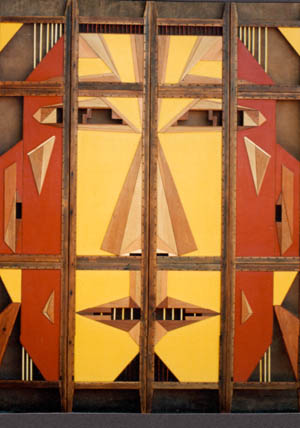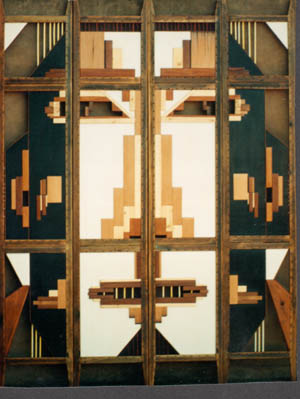
Side one

Side two
The Four Faces
1997Screen
Wood Applique
96" X 84"


Side two
An alternate title was, 'The Four Races', but in contemporary times it could be titled 'Genome'. As evolution progressed from soup to salad to meat, Nature's core formula for life became established. From the last half of the past century much ado was made of the term 'nurture', that the environment was the major factor for human behavior. But, since then, there have been great leaps of scientific technology and the 'nature' theory is taking hold. It is now being explained that ethnic differences are only a handful of pebbles in a sea of stones.
Having spent some time in the U.S.A., the artist has concluded that outright racism exists there. In Canada, there is a softer, quieter, insidious bigotry. One wonders, when the rant of hate exudes from words and actions, from which gene pool these actions come (nature) and what happened to them (nurture).
The surfaces of the frame are left clear to show the historic character, the physical basis of all humankind The masks themselves are coated with paint, the colors having the same formula with just a dash of pigment thrown in. The pieces of wood representing the different races are rectangular on one side and triangular on the other but the edges are all straight lines emphasizing our similarities. Because sculpture is a three-dimensional process the viewer participates by moving toward and around the piece. The initial image of a large face is captured from a distance. As one approaches more closely, one notices the holes representing the eyes, ears, nose and mouth. These were designed to evoke the feeling of infinity passing through the face. As one moves closer and around the piece, the shapes and colours define the differences.
The Four Faces is the second piece from the artists phase which defines the 'present. He has moved from highlighting only the natural characters of wood to using the less holistic technique of including more man made materials such as plywood ,dowels and paint. The bright colours used by the peoples of the southwest and present in the surroundings there also influenced him. The joinery is a combination of mortise and tenon, splines and dowels. The parts of the face are attached by the 'Santa Fe Applique' technique.